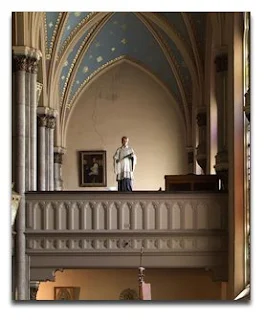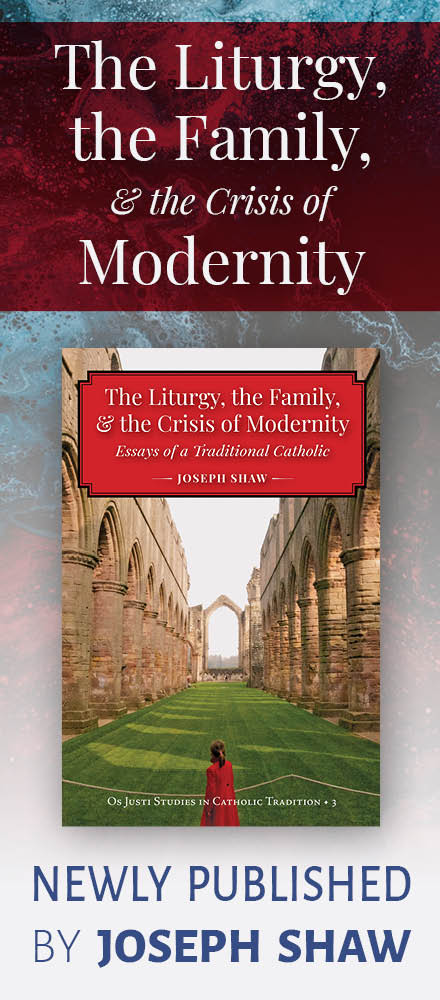Within some circles, I've begun to notice a line of commentary on liturgical matters that follows a predictable pattern: 1) condemn the old days (vestments, architecture, music etc.) as obviously and non-debatably bad and alienating; 2) acknowledge the failures of the post-1970 reform efforts as also bad; 3) encourage some yet-to-be explained 3rd alternative that will solve all problems but remains yet unproven.
This whole line of argument strikes me as debilitating in some ways but also a sign that we are currently in the thick of a transition that could end up yielding good fruit.  An example of this type of argument comes from Today's Liturgy (May 2008): "Congregational Singing: A Constant Challenge" by Most Rev. Ronald P. Herzog , Bishop of Alexandria, Louisiana.
An example of this type of argument comes from Today's Liturgy (May 2008): "Congregational Singing: A Constant Challenge" by Most Rev. Ronald P. Herzog , Bishop of Alexandria, Louisiana.
He writes of the old positioning of the choir (p 16-17):
Older churches, built to meet the needs of pr-Vatican II celebrations, usually had elevated lofts for choirs, and it was the choir that added any musical components to the Mass. Here, the architecture does not really invite those seated in the nave to take part. The distance and difference in elevation convey the impression, even if unintended, that those in the loft sing while those in the nave listen. This separation is further enhanced if the music is difficult or unfamiliar. Add to this the absence of a leader of song and it is not that surprising that many people who have had no musical training or experience are shy, even intimidated.
There are points here that need to be addressed, among which is the assumption that people want to sing but are prevented from feeling the desire because of the architecture, and also the presumption that community singing is a more important value than, say, solemnity or beauty. The precise cause and effect between lofts and non-participation is certainly unproven, for we've all be present at counter examples.
In any case, that paragraph above is not surprising. It is conventional and reflexive anti-preconciliarism, It's been true for decades that you can attribute anything that you don't like to the legacy of preconciliar Catholicism and the reader will have no choice but to robotically nod agreement.
What matters here is his next statement:
A variation on this architectural issue can be seen in church buildings, even newer structures, in which the musicians are located in front of the congregation. This may be done for practical reasons—there may be no other space, other than possibly a loft that will accommodate the people involved—but this, too, inhibits the participation of the congregation for various reasons, both psychological and practical. If you have ever attended a concert or play, you know that performers are usually right in front of the audience; it is an almost automatic response for us to watch and listen when we are physically positioned to do exactly that. The situation becomes even more complicated if the musicians are quite good; people will often say they enjoy listening to good music and don't want to "mess it up" by singing along. An additional subtle contributor what I'll call the "audience effect" is the fact that, by the time we hear sound coming from in front of us, it is almost too late to add to it. Conversely, if sound comes from behind us and is moving forward, the possibility of adding to it as it passes over or through us becomes easier.
Now, here is a very true, and frankly devastating, case against putting choirs within the view of the congregation. The sound should come from behind so that people can add their voices to it. The very goal of the reformers turned out to be unachieved by the expensive and often offensive change. Why didn't anyone think of this before we tried decades in which performing bands stared at us during Mass and strummed?
But now we are left with the problem of what to do. The sound can't come directly from behind because then it will stop at the backs of the people on the back row. It must come from above to have the effect of traveling through the congregation, a fact confirmed by many acoustic engineers.
Doesn't this then make the case for the loft? One might think so but he has already said that this is bad because it makes the music seem somehow apart. What are we to do? The choir is either visible like performers, in which case people don't sing, or invisible and apart, in which case people don't sing. He has provided no answer at all, unless you take his hint that good music deters inclusion, in which case we should be fostering bad music so that people voices can't make it worse (I know you are thinking that this explains a lot!) Or maybe everyone should have a personal iPod. Who knows!
It seems obvious that lofts are the answer. I've only seen a few that are so far away that you really do have the sense that you can't sing else you will mess it up. Why can't he just admit that there was wisdom in the old ways?




















